The nature garden
When COVID-19 lockdown had us slowing down and staying local, we couldn’t help but get closer to nature. And, as if to reward us for not rushing around in our cars, the birds really made their presence felt. Many of us noticed more birds in our back yards and also a greater variety of birds. Now as everyone gets back to business, it’s nice to think some of these positive effects of lockdown will remain.
One way to encourage the birds to stick around is to make sure our gardens are the kinds of places they want to be. As we take advantage of winter planting time, we can choose trees and shrubs that provide food and safe lodgings for birds, and an appealing place to build their nests. Winter in particular is a good time to attract birds to gardens, because at this time of year their usual food supplies are more scarce.
Native trees and shrubs are the natural choice but they aren’t the only plants that native birds will flock to in search of nectar, berries and insects. Some of the most colourful plants in the winter garden also happen to be bird favourites.
Golden kowhai trees drip with nectar-filled blossom during late winter and spring, a treat for tui and bellbirds. Later, the kereru will feast on kowhai’s fresh spring growth. Kowhai cousins, the kakabeaks, with flowers shaped just like parrot beaks, are also favourites with our native wildlife.
Tui and silvereyes love Pohutukawa but they also adore the Australian bottlebrushes, which fit better into town sized gardens. Their bright pohutukawa- red flowers occur mainly in spring but also intermittently all year round.
Vibrant winter flowering grevilleas and banksias are other Aussie favourites enjoyed by gardeners and birds alike. From South Africa come striking proteas, aloes and hot pokers (Kniphofia), all well known for their bird attracting powers. These mainly frost tender shrubs are great for coastal gardens.
Camellias, especially the single flowering forms with prominent stamens, also provide nectar for birds. Often fragrant, camellias flower throughout New Zealand during autumn, winter and spring. Colourful and good in part shade, chinese lantern shrubs (Abutilon) produce year-round food for nectar seeking birds.
Be sure to include a few taller shrubs or small trees if you want to improve the biodiversity in your garden. As well as offering shelter and privacy for people, taller evergreens offer a habitat for birds in search of a safe nesting spot and insects to eat. Birds like to sit in high branches where they can keep an eye out for danger before swooping to a bird bath or feeder.
Quick growing native corokias and coprosma are ideal. Their autumn berries feed a wide range of birds, including kereru. Birds are also partial to the berries of the cabbage tree, while the bees will flock to its fragrant summer flowers. Nectar packed flax flowers are popular with tui. Generally, the plain green flax varieties are the most prolific flowering.
If possible, grow enough fruit for your family and the birds. Silvereyes can be seen gorging on persimmons and figs in late autumn. Loquat and guava trees are popular with kereru. If there is space for a larger tree, a beautiful puriri tree will provide a food source for both nectar and berry feeding birds plus a solid perch for the weighty kereru.
While waiting for your plantings to turn your garden into the bird haven of your dreams, you can invite feathered friends by supplementing their winter diet. Bread is harmful to birds, but they will thank you for topping up your bird feeders with sugar syrup and the right kinds of seeds. Garden centres stock a range of bird feeders and top quality seed suitable for wild birds. Keep bird feeders well out of reach of cats.
Birds are attracted to water in a garden, especially the sound of running water in summer.

28-Jun-2020
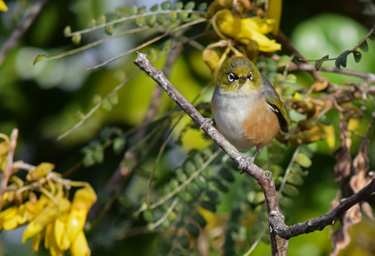
Silvereye on kowhai
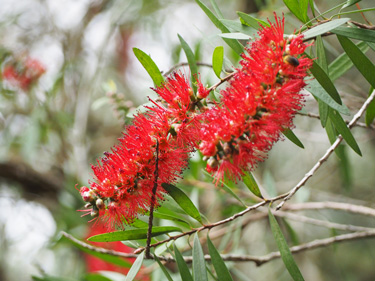
Callistemon - bottlebrush
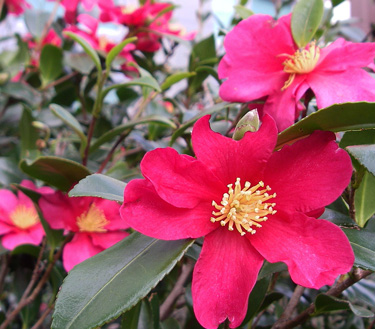
Camellia single flowering with prominent stamens
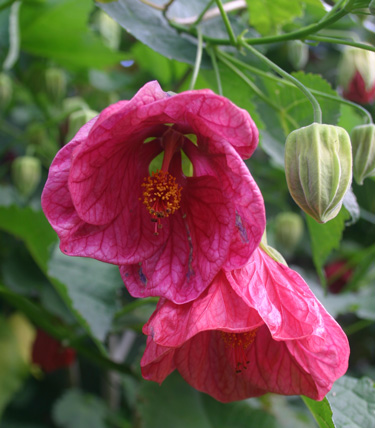
Abutilon - Chinese lantern
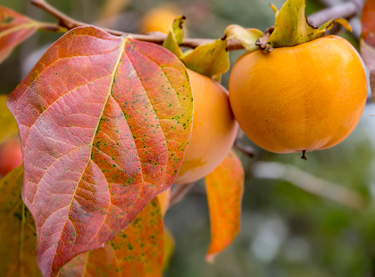
Persimmon

